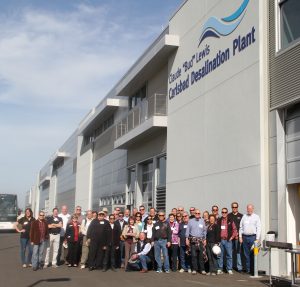
Pictured is a tour group from Imperial Valley who visited the Claude “Bud” Lewis Carlsbad Desalination Plant earlier this year. On Dec. 14, the plant celebrated its first year of operation.
On Wednesday, Dec. 14, the Claude “Bud” Lewis Carlsbad Desalination Plant reached a critical milestone—completing its first full year of operation. It was in December 2015 that the plant opened in an event that brought together 600 elected officials, community leaders and project partners from throughout the region. During this first year the plant has produced about 10 percent of the San Diego region’s water demand. More specifically, the plant produced nearly 15 billion gallons of fresh water—about 45,000 acre-feet—for the region during one of the most severe droughts in state history.
The Carlsbad Desalination Plant is the result of a 30-year, public-private partnership between the plant’s developer and owner, Poseidon Water, and the Water Authority for the production of up to 56,000 acre-feet of water per year – enough to meet the needs of approximately 400,000 people. It is a major component of the Water Authority’s multi-decade strategy to diversify the region’s water supply portfolio.
The $1 billion desalination project includes three main components: the desalination plant adjacent to NRG Energy’s Encina Power Station on Agua Hedionda Lagoon; a 10-mile pipeline that connects to the Water Authority’s regional distribution system; and upgrades to Water Authority facilities for distributing desalinated seawater throughout the region.
It costs about a half-cent to produce a gallon of drinking water at the plant. Desalinated water costs typical homeowners in the region about an additional $5 per month, in line with the low end of projections when the project was approved in late 2012.
Since the drought of 1987-92, the Water Authority has transformed the region’s water supply mix through a long-term strategy to diversify its water supplies and enhance regional water infrastructure. Elements of the strategy include, implementing the nation’s largest agriculture-to-urban water conservation and transfer agreement with the Imperial Irrigation District; securing additional long-term, highly reliable Colorado River water supplies through canal-lining projects in the Imperial Valley; assisting local member agencies in developing their own local water sources; and helping reduce regional per capita potable water use by nearly 40 percent between 1990 and 2015 through legislation, education, incentives and other measures to promote conservation and water-use efficiency.
